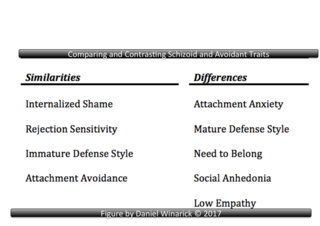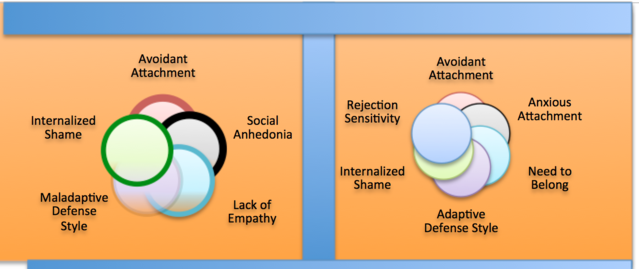Personality
The Disappearance of the Schizoid Personality
Empirical evidence supports retaining one of the original personality disorders.
Posted January 2, 2017 Reviewed by Jessica Schrader
Lack of research and scholarly attention has led important personality dynamics once captured by the schizoid diagnosis to be overlooked. Once an immensely important construct, schizoid personality disorder is at risk of becoming diagnostically irrelevant. Many have argued that this is the result of the emergence of avoidant personality disorder (AVPD), a similar yet theoretically distinct syndrome (see e.g., Ahktar, 1987; Livesley et al., 1985).

Schizoid and avoidant personality disorders have been categorized as separate types because different motivations are thought to underlie their social isolation. According to the current DSM (DSM-5, APA, 2013), individuals with schizoid personality disorder reportedly do not desire relationships because of deficits in their capacity to relate meaningfully with others whereas individuals with avoidant personality disorder reportedly desire relationships but fear rejection, shame, and humiliation.
This conception leaves two abnormal, maladaptive sub-types of introversion: schizoid withdrawal and avoidant withdrawal:
- Social withdrawal based on anxious-fearfulness is considered avoidant.
- Social withdrawal based on apathy, anhedonia, and indifference as well as a preference for solitude is considered schizoid.
Isolated, detached, and withdrawn individuals were not always viewed as separable on the basis of sensitivity to evaluation of others or the potential—or lack-thereof—for positive emotional experience in social interaction. In fact, quite the opposite was true. Hypersensitivity and detachment were viewed as going together (in parallel and interval) in abnormal, maladaptive introversion.
Historical perspectives on a common schizoid-avoidant syndrome: Outer appearances and internal dynamics
"Like a mollusk without a shell--that is the surface. Or else the surface is just nothing; we see a man who stands in our way like a question mark [...] there are schizoid men, with whom we can live for ten years and yet we may not say for certain we know them" –E. Kretschmer (1925, From Physique and Character, pp. 146).
The debate about the validity of the schizoid-avoidant distinction centers on whether the different behavioral manifestations described by Kretschmer above as timid, flat, or hostile coupled with the internal experience of hypersensitivity and tendency to escape into one's thoughts reflect different types of disorders or whether they are subtypes of a common syndrome, such as abnormal, maladaptive introversion.
There has always been an interest within clinical psychology and psychiatry in understanding isolated, detached, and withdrawn individuals (for a review, see Livesley et al., 1985):
- Kraepelin described "seclusiveness" as an introversion-based schizophrenia-spectrum personality type
- Bleuler coined the term "schizoid" to refer to Kraepelin's construct
- Hoch preferred the term "the shut-in personality"
- Kretschmer highlighted the internal sensitivity of schizoids despite outward displays of coldness
The schizoid-avoidant categorical distinction: Evaluating empirical evidence for a controversial differential diagnosis

Given the historical importance of schizoid personality disorder for research on schizophrenia-spectrum pathology, psychodynamic theory (e.g., Klein, Guntrip, and McWilliams), and personality disorders, it is surprising how little research there is evaluating the distinction between avoidant personality disorder and schizoid personality disorder. In light of impressively constructed and researched arguments that such a distinction rendered schizoid personality disorder an invalid construct and its proposed removal, it seems responsible to evaluate the validity of its distinction from avoidant personality disorder. The existence of isolated, detached, and withdrawn individuals who lack affiliative motivation, prefer solitude, do not experience pleasure from friendships and family, and are indifferent to external judgments would provide empirical support for the validity of post DSM-III schizoid personality disorder, suggesting it should not be removed.
Do such characters like Daniel Day Lewis in There Will Be Blood, who utters the line "There are times when I look at people and I see nothing worth liking. I want to earn enough money that I can get away from everyone," exist without inner sensitivity?
Winarick & Bornstein (2015) found that schizoid personality disorder and avoidant personality disorder items show unique patterns of correlations with theoretically relevant traits in many expected ways. Items tapping the need to belong and attachment anxiety were uniquely significantly correlated with avoidant personality disorder items. Items tapping social anhedonia and low empathy were uniquely correlated with schizoid personality disorder. This finding supports the validity of the DSM differential diagnosis. However, both schizoid personality disorder and avoidant personality disorder items were significantly correlated with rejection sensitivity (small r for the schizoid personality disorder link) and internalized shame (large r for schizoid personality disorder and avoidant personality disorder) items. This finding suggests that schizoid personality disorder items are linked with hypersensitivity, inconsistent with post DSM-III definitions but consistent with Meehl's schizotypy (Meehl, 1962), dimensional trait theorists, aspects of psychodynamic theory, and early descriptive psychiatry.
Below is a figure representing the correlation clusters for schizoid personality disorder and avoidant personality disorder, respectively - without the rejection sensitivity-schizoid personality disorder correlation included. There is considerable overlap but also clear contrasts (avoidant personality disorder on the right; schizoid personality disorder on the left).

Where will all the schizoids go? They will be diagnosed as avoidant or schizotypal.
If the dearth of research on schizoid personality disorder continues, then there is a good chance the DSM-5 proposal will get realized, and schizoid personality disorder will be removed. Yet the proposal also calls for re-coupling social anhedonia with anxious/hypersensitivity by moving the schizoid personality disorder symptom over to avoidant personality disorder. The long reign of the label schizoid as a diagnosis will come to an end but the schizoid construct will live on, sort of.
A note to readers: Stay tuned for a discussion of the legacy of schizoid personality disorder and discussion of what aspects of the construct will be lost or retained should it be re-named avoidant PD in the DSM-VI. Also much more.
This post nor any other I write should be construed as suggesting that a certain behavior or psychological process by itself is diagnostic of a mental disorder. It is irresponsible to make any diagnostic suggestions about a person without meeting them and conducting a thorough interview.
References
Ahktar, S. (1987). Schizoid personality disorder: A synthesis of developmental, dynamic, and descriptive features. American Journal of Psychiatry, 42 (4), 499-518.




